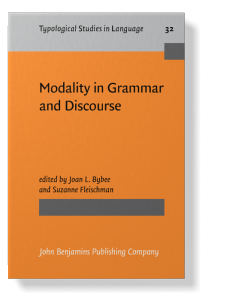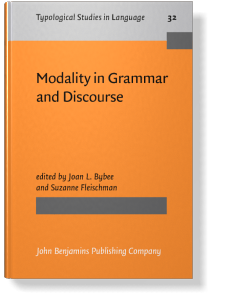Modality in Grammar and Discourse
Editors
This volume brings together a collection of 18 papers that look into the expression of modality in the grammars of natural languages, with an emphasis on its manifestations in naturally occurring discourse. Though the individual contributions reflect a diversity of languages, of synchronic and diachronic foci, and of theoretical orientations all within the broad domain of functional linguistics they nonetheless converge around a number of key issues: the relationship between 'mood' and 'modality'; the delineation of modal categories and their nomenclature; the grounding of modality in interactive discourse; the elusive category 'irrealis'; and the relationship of modal notions and categories to other categories of grammar.
[Typological Studies in Language, 32] 1995. viii, 575 pp.
Publishing status: Available
© John Benjamins Publishing Company
Table of Contents
-
Introduction | p. 1
-
I. Agent-Oriented and Epistemic Modality
-
Agent-Oriented vs. Epistemic Modality: Some Observations on German ModalsBernd Heine | p. 17
-
The Expression of Root and Epistemic Possibility in EnglishJennifer Coates | p. 55
-
Contextuel Conditions for the Interpretation of poder and deber in SpanishCarmen Silva-Corvalán | p. 67
-
The Obligation Modality in Western Nilotic LanguagesEdith L. Bavin | p. 107
-
The Gestural Expression of Modality in ASLSherman Wilcox and Phyllis Perrin Wilcox | p. 135
-
II. The Interactional Basis of Modality
-
The Development of Epistemic Sentence-ending Modal Forms and Functions in Korean ChildrenSoonja Choi | p. 165
-
The Interactional Basis of the Mandarin Modal néng ‘can’Jiansheng Guo | p. 205
-
The Discourse and Interactive Functions of Obligation ExpressionsJohn Myhill and Laura A. Smith | p. 239
-
Apprehensional EpistemicsFrank Lichtenberk | p. 293
-
Moods and MetaMessages: Alienation as a MoodJohn Haiman | p. 329
-
III. Irrealis Modality and Subjunctive
-
The Realis-Irrealis Distinction in Caddo, the Northern Iroquoian Languages, and EnglishWallace Chafe | p. 349
-
On the Relativity of IrrealityMarianne Mithun | p. 367
-
The Grammaticalization of Irrealis in Tik PisinSuzanne Romaine | p. 389
-
The Evaluative Function of the Spanish SubjunctivePatricia V. Lunn | p. 429
-
IV. Modality and Other Categories of Grammar
-
Negation and the Modals of Possibility and NecessityFrank Robert Palmer | p. 453
-
A Functional Theory of ComplementizersZygmunt Frajzyngier | p. 473
-
The Semantic Development of Past Tense Modals in EnglishJoan L. Bybee | p. 503
-
Imperfective and IrrealisSuzanne Fleischman | p. 519
-
Subject index | p. 553
-
Language index | p. 565
-
Author index | p. 569
Cited by (111)
Cited by 111 other publications
Aneta Kšenžighová
Alboiu, Gabriela & Virginia Hill
Bokharaeian, Behrouz, Mohammad Dehghani & Alberto Diaz
Fois, Eleonora
2023. Chapter 7. Redefining English language teaching in translator training through corpus-based tasks. In Instrumentalising Foreign Language Pedagogy in Translator and Interpreter Training [Benjamins Translation Library, 161], ► pp. 112 ff. 
KOŞUMCU, Selenay
Li, Dongqi
Manfredi, Stefano & Slavomír Čéplö
2023. A corpus-driven description ofoin Naijá (Nigerian Pidgin). Journal of Pidgin and Creole Languages 38:2 ► pp. 290 ff. 
Serrano, María José
Tenca, Emanuela
Yang, Lei, Yue Zhang & Manfu Duan
ÖZBAY, Ali Şükrü & Zehra GÜRSOY
Martirosyan, Anush
MÉLAC, ERIC
Mélac, Eric
2024. The links between evidentiality, modality, and grammaticalization. Studies in Language 48:3 ► pp. 513 ff. 
Ostovar-Namaghi, Seyyed Ali, Fatemeh Khorram & Farhad Moezzipour
2022. Exploring the use of modality in EFL learners’ writing. English Text Construction 15:1 ► pp. 68 ff. 
Chang, Miao-Hsia & Ún-giân Iûnn
2021. A corpus-based study of directives in Taiwanese Southern Min. Concentric. Studies in Linguistics 47:2 ► pp. 300 ff. 
Cruz, Aline da & Bárbara Heliodora Lemos de Pinheiro Santos
Fornieles Sánchez, Raquel
Hilpert, Martin, Bert Cappelle & Ilse Depraetere
2021. Modality in Diachronic Construction Grammar. In Modality and Diachronic Construction Grammar [Constructional Approaches to Language, 32], ► pp. 1 ff. 
Salama, Amir H.Y.
Themistocleous, Charalambos, Kimberly Webster, Alexandros Afthinos & Kyrana Tsapkini
Yuasa, Etsuyo
2021. Constructionalization of Japanese koto imperatives. In Modality and Diachronic Construction Grammar [Constructional Approaches to Language, 32], ► pp. 219 ff. 
Depraetere, Ilse & Susan Reed
Gawne, Lauren
Lorenz, David & David Tizón-Couto
2020. Chapter 4. Not just frequency, not just modality. In Re-Assessing Modalising Expressions [Studies in Language Companion Series, 216], ► pp. 79 ff. 
Schwarzwald, Ora R.
2020. Chapter 7. Inflection. In Usage-Based Studies in Modern Hebrew [Studies in Language Companion Series, 210], ► pp. 147 ff. 
Böhm, Verónica
2019. Speaker’s stance and subjectivity in the epistemic modal and evidential use of the Spanish imperfecto in journalistic texts. Dutch Journal of Applied Linguistics 8:1 ► pp. 84 ff. 
Colasanti, Valentina & Giuseppina Silvestri
2019. Matrix complementizers in Italo-Romance. In Italian Dialectology at the Interfaces [Linguistik Aktuell/Linguistics Today, 251], ► pp. 155 ff. 
Kuteva, Tania, Bernd Heine, Bo Hong, Haiping Long, Heiko Narrog & Seongha Rhee
Qian, David D. & Mingwei Pan
Bocale, Paola
Manfredi, Stefano
2018. The semantics of modals in Kordofanian Baggara Arabic. In Afroasiatic [Current Issues in Linguistic Theory, 339], ► pp. 131 ff. 
Wada, Naoaki
2018. C-gravitation and the grammaticalization degree of “present progressives” in English, French, and Dutch. In New Trends in Grammaticalization and Language Change [Studies in Language Companion Series, 202], ► pp. 207 ff. 
Cap, Piotr
Hofmockel, Carolin
Pham, Teresa
Cheng, Maria
Goria, Eugenio
2016. The role of extra-clausal constituents in bilingual speech. In Outside the Clause [Studies in Language Companion Series, 178], ► pp. 273 ff. 
Goria, Eugenio
2017. Chapter 16. Functional markers in llanito code-switching. In Pragmatic Markers, Discourse Markers and Modal Particles [Studies in Language Companion Series, 186], ► pp. 439 ff. 
Hilpert, Martin
Taboada, Maite
Wu, Yicheng & Daogen Cao
2016. Object expletives in Chinese and the structural theory of predication. International Journal of Chinese Linguistics 3:2 ► pp. 179 ff. 
Yu, Hailing & Canzhong Wu
Givón, T.
Tournadre, Nicolas & Pierre Cadiot
Xu, Hongzhi, Dingxu Shi & Chu-Ren Huang
Yang, Xu
Zevakhina, Natalia & Svetlana S. Dzhakupova
Šandová, Jana Kozubíková
Alba-Juez, Laura & Geoff Thompson
2014. The many faces and phases of evaluation. In Evaluation in Context [Pragmatics & Beyond New Series, 242], ► pp. 3 ff. 
Alonso Almeida, Francisco & Margarita Mele-Marrero
2014. Stancetaking in seventeenth-century prefaces on obstetrics. Journal of Historical Pragmatics ► pp. 1 ff. 
Conti, Luz
Conti, Luz
Cresti, Emanuela
2014. Syntactic properties of spontaneous speech in the Language into Act Theory. In Spoken Corpora and Linguistic Studies [Studies in Corpus Linguistics, 61], ► pp. 365 ff. 
Deshors, Sandra & Stefan Th. Gries
2014. A case for the multifactorial assessment of learner language. In Corpus Methods for Semantics [Human Cognitive Processing, 43], ► pp. 179 ff. 
Flaux, Nelly & Véronique Lagae
Hidalgo Downing, Laura
2014. The role of negative-modal synergies in Charles Darwin’sThe Origin of Species. In Evaluation in Context [Pragmatics & Beyond New Series, 242], ► pp. 259 ff. 
Hidalgo‐Downing, Laura
Huschová, Petra
Huschová, Petra
Kuznetsova, Nadežda & Eleonora Usenkova
Laks, Lior & Ruth A. Berman
Liu, Chin-Ting Jimbo & Hsiu-Fen Hélène Lee
Lokmane, Ilze & Andra Kalnača
2014. Modal semantics and morphosyntax of the Latvian DEBITIVE. In Modes of Modality [Studies in Language Companion Series, 149], ► pp. 167 ff. 
Taboada, Maite, Marta Carretero & Jennifer Hinnell
2014. Loving and hating the movies in English, German and Spanish. Languages in Contrast 14:1 ► pp. 127 ff. 
Taboada, Maite, Marta Carretero & Jennifer Hinnell
2016. Loving and hating the movies in English, German and Spanish. In Genre- and Register-related Discourse Features in Contrast [Benjamins Current Topics, 87], ► pp. 127 ff. 
Vydrina, Alexandra
2014. From agent-oriented modality to sequential. In Modes of Modality [Studies in Language Companion Series, 149], ► pp. 379 ff. 
Ferrari, Lilian & Eve Sweetser
Gray, Bethany & Douglas Biber
Plungian, Vladimir A.
2012. Review of Rothstein & Thieroff (2010): Mood in the languages of Europe. Functions of Language 19:2 ► pp. 293 ff. 
Zamorano-Mansilla, Juan Rafael & Marta Carretero
Лорентцен, Елена
Traugott, Elizabeth Closs
Hsieh, Chia-Ling
Rullmann, Hotze, Lisa Matthewson & Henry Davis
Moore, Colette
Edwards, Derek
Bibok, Károly, Julia Coryell & Saihua Xia
Dunmire, Patricia L.
Duranti, Alessandro
Hoye, Leo Francis
Hoye, Leo Francis
REILLY, J, A ZAMORA & R MCGIVERN
KOCKELMAN, PAUL
Robichaud, Daniel, Hélène Giroux & James R. Taylor
Barbara Shaffer
Sterponi, Laur A.
Taljard, Elsabé & Louis J. Louwrens
Bouldin, Paula, Edith L. Bavin & Chris Pratt
Janzen, Terry, Barbara Shaffer & Sherman Wilcox
Janzen, Terry, Barbara Shaffer & Sherman Wilcox
2022. Signed language pragmatics. In Handbook of Pragmatics [Handbook of Pragmatics, ], ► pp. 1209 ff. 
Fabricius-Hansen, Cathrine
Hacking, Jane F.
Sexton, A.L.
Taylor, James R.
Taylor, James R.
Nordlinger, Rachel & Elizabeth Closs Traugott
Moreno Benítez, Damián
[no author supplied]
[no author supplied]
This list is based on CrossRef data as of 20 july 2024. Please note that it may not be complete. Sources presented here have been supplied by the respective publishers. Any errors therein should be reported to them.
Subjects
Main BIC Subject
CF: Linguistics
Main BISAC Subject
LAN009000: LANGUAGE ARTS & DISCIPLINES / Linguistics / General

